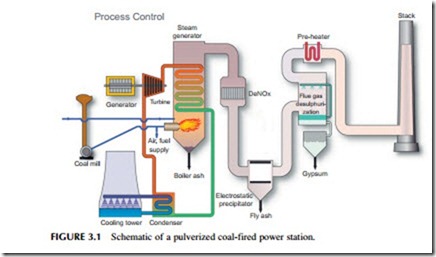TRADITIONAL COAL-FIRED POWER GENERATION TECHNOLOGY
The traditional method of producing electricity from coal is to burn the fuel in air and capture the heat released during the combustion in a boiler where it is used to raise steam, the latter driving a steam turbine generator. This type of power plant has been evolving since the modern steam turbine was invented by Charles Parsons in 1884. His first unit drove a dynamo that produced 7.5 kW of electrical power.
A power plant of this type is made up of several key components (Figure 3.1). There will be a fuel handling system designed to receive the bulk
coal deliveries from the mine and convert the mined coal into a form that can be readily burned. In most modern coal-fired power plants this involves crushing the fuel to produce a powder. This pulverized coal is then fed into a combustion system where it is mixed with air and ignited under controlled conditions, releasing chemical energy as heat. This heat is captured by water within tubes in the boiler, the heat energy converting the water into steam. The combustion system and boiler must be closely integrated for highest efficiency and will nor- mally be considered a single unit in modern plants. Once combustion is complete most of the ash residue falls to the bottom of the combustion chamber and is removed as slag. However, some ash forms into fine particles that are carried away with the hot combustion gases. These particles must be removed at a later stage.
Steam generated in the boiler is carried to a steam turbine that is designed to extract as much heat energy as possible from the gas. In a large coal-fired power station the steam turbine is likely to be composed of at least three elements: a high-pressure (HP) turbine, an intermediate-pressure (IP) turbine, and one or more low-pressure (LP) turbines. Steam passes from one to the next in sequence. Higher efficiency can often be achieved by reheating the steam between the HP and IP turbines by returning it through a special stage of the boiler called a reheater.
To extract the maximum amount of energy from the steam, a condenser is fitted to the output of the LP turbine(s) to condense the steam back into water. The colder the cooling water used in the condenser, the higher the efficiency will be. The water is then returned to the boiler and passes around the cycle again.
The hot flue gases that exit the combustion chamber of the plant and pass through the boiler are rich in carbon dioxide and laden with impurities. These impurities include sulfur dioxide, nitrogen oxide, heavy metals, organic com- pounds, and tiny ash particles. All these impurities must be removed before the flue gas can be released into the atmosphere. Cleaning is carried out in a sequence of flue-gas cleaning systems, each a separate chemical or filtration plant. Carbon dioxide in not currently removed from commercial coal-fired power plants, but technology for its capture is advanced and is expected to be deployed within a decade. A plant that applies all these processes, including carbon dioxide capture, may be called a zero-emission plant, although in fact, traces of all will still be released.
Efficiency is the key to modern coal-burning technology. The higher the ratio of electrical energy output to chemical energy input of the coal combustion process, the cheaper each unit of electricity produced will be. For modern plants without carbon dioxide capture, higher efficiency also means lower emissions per unit of electricity produced.
Of the chemical energy contained with the coal, around 15% is lost to the energy conversion system. The remainder is utilized to heat steam so that the hot steam contains around 85% of the original chemical energy. Converting the hot steam into electricity relies on the Carnot thermodynamic cycle. Con- version efficiency depends on the temperature and pressure of the steam (more accurately the temperature and pressure drop that is achieved between steam turbine inlet and outlet), so the development of coal-fired power plant technology is directed at producing steam at the highest temperature and pressure possible. From an energy viewpoint, therefore, the two most important components of a coal-fired power station are the boiler, which produces high-temperature, high-pressure steam, and the steam turbine, which must then convert the energy carried by that steam into electrical energy.
